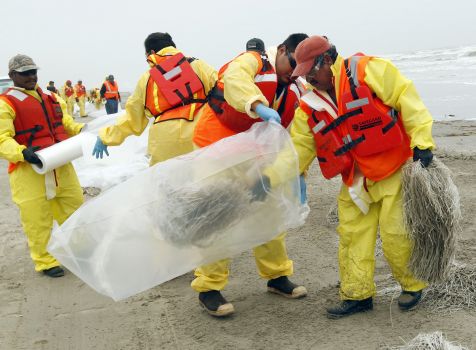http://www.mysanantonio.com/news/environment/article/Latest-oil-incident-belies-painful-truth-5381316.php

Photo By Jennifer Reynolds / Galveston County Daily News
Oil spill response crews remove absorbent material on the beach in Galveston. About 170,000 gallons of oil spilled into Galveston Bay on March 22.
BY MATTHEW TRESAUGUE, HOUSTON CHRONICLE : APRIL 6, 2014
HOUSTON – Shortly before noon March 30, a storage tank on a platform in the northernmost lobe of Galveston Bay began overflowing because of an equipment malfunction. At least 160 gallons of light crude oil poured into the water and spread to nearby marshes.
The incident mainly occurred in the background, as attention was focused on a larger problem across the bay, where crews were in their ninth day of cleaning up nearly 170,000 gallons of heavy oil spilled by a punctured barge.
The one-two punch underscores a depressing truth about these blue-collar waters: Oil spills happen almost every day.
Galveston Bay has averaged 285 spills a year since 1998, according to the Houston Advanced Research Center, which publishes periodic reports on the state of the bay’s ecosystem.
The spills typically are small, averaging 103 gallons per incident. Most were less than a gallon. Yet the spills occur frequently enough to raise concerns about the health of the bay.
“It’s like death by a thousand cuts, especially when you combine the oil spills with all of the other stressors to the bay,” said Lisa Gonzalez, a marine scientist who serves as the Houston Advanced Research Center’s vice president.
The area’s growing human footprint has taken a toll. More than 35,000 acres of coastal marshes have disappeared, primarily because of subsidence, the sinking of soft soils because of groundwater pumping.
The bay remains resilient, however, as the most productive and commercially valuable bay and estuary system in Texas and the heart of the state’s $2 billion fishing industry. Experts say the size of the fishing industry suggests that the bay is healthy. But it’s hard to tell because the ecosystem is always changing, and scientific knowledge is lacking.
Antonietta Quigg, a marine biologist at Texas A&M University at Galveston, said spilled oil is a chronic issue with long-term consequences for the bay’s animals and plants. For years, Quigg has measured the bay’s health through plankton, some of the smallest, most sensitive organisms in the water.
In the first days after the March 22 spill, Quigg’s research team took water samples near where the Summer Wind, a bulk carrier as long as a football field, collided with a barge, causing heavy bunker fuel oil to empty into the lower end of the bay.
The winds and waves pushed the black goo into the Gulf of Mexico instead of the fragile estuaries ringing the bay. While some consider the oil’s movement to be a lucky break, the spill still caused harm.
It’s still too early to tell how the spill affected plankton. But Quigg’s preliminary findings show oil-consuming bacteria, which occur naturally in the bay’s subtropical waters, are helping to clean up the mess.
The oil spill was the largest in the bay since a 1990 collision between a tanker and three barges released about 700,000 gallons of heavy crude into the Houston Ship Channel, just south of Redfish Island. The incident was larger than all spills combined for Galveston Bay in any given year since 1998, according to the Texas General Land Office.
It received 284 reports of oil spills in the bay in 1998, the first year of the state agency’s data. That number peaked at 397 incidents in 2001 and since has trended downward, with a low of 184 spills in 2011.
“We have gone from a culture 30 years ago where (if) you spilled something you didn’t tell anybody, where today if you spill something, regardless of the amount, you self-report,” said Texas Land Commissioner Jerry Patterson.
Even with greater attention to preventing spills, oil inevitably gets into the water.
The recent spill from the storage tank was blamed on a high-water alarm that failed. Oil-laced water poured over the brim and fouled at least 300 yards of marshland, said Scott Gaudet of the land office.
“We’ve made good progress, and there are fewer spills in the bay,” he said. “But tanks overflow, hoses leak and people make mistakes.”
Special thanks to Richard Charter